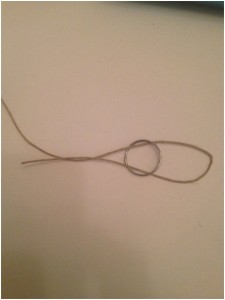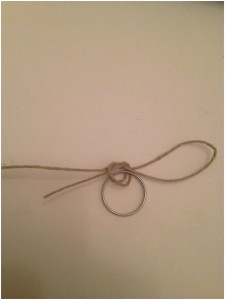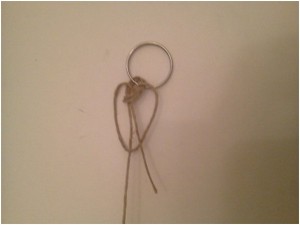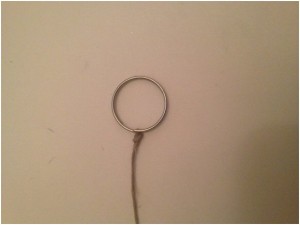By Levi Opsatnic.
If you remember, I’ve detailed how to tie the Nail Knot and the Loop-to-Loop knot. Now, I’ll finish my discussion of crucial fly fishing knots by explaining the knot that is necessary to successfully attaching your fly to the tippet. This knot is called the Palomar Knot, and for the demonstration I will use a circular piece of metal so it can be seen easier.
In my experience this knot is the strongest and most low profile knot there is to tie your fly onto your tippet. In fact, I have found that often your tippet will break before the knot does, and for that reason I use this knot almost exclusively when tying flies onto my tippet.
- Run your tippet through the eye of the hook and turn it around and bring it back through the eye again. This effectively doubles your line through the eye and creates a loop on one end and two pieces of material on the other.

- Once you have doubled your tippet through the eye, hold your loop in one hand and both your main tippet and the tag end of your tippet in the other. Tie an overhand knot creating a loop at the end of your tippet. Don’t panic. This loop will later be used to finish the knot.

- Now take the loop in the end of your tippet and manipulate the hook through it so it is now on the opposite side of your hook.

- Once your loop is oriented on the other side of your hook you can pull it tight. (Tip: I have found that you really only need to pull one end of the tag in order to tighten the knot. In fact only pulling the tag end will result in having to cut less of your tippet off in the end.)
Final Knot
As you can see, knots don’t have to be as complicated as they are made out to be. With the right amount of practice you can have yourself tying these knots in pitch black conditions with swarms of mayflies buzzing around you. After all, that is when the fishing is best.
One final thing to remember about knots is that when pulling them tight, they will also move better and easier with a little bit of lubricant. Most fly fishers tend to use saliva; however, that is not always the most sanitary methods. I would suggest simply using some of the water from the stream or lake you are fishing.
Happy fly fishing everyone!

